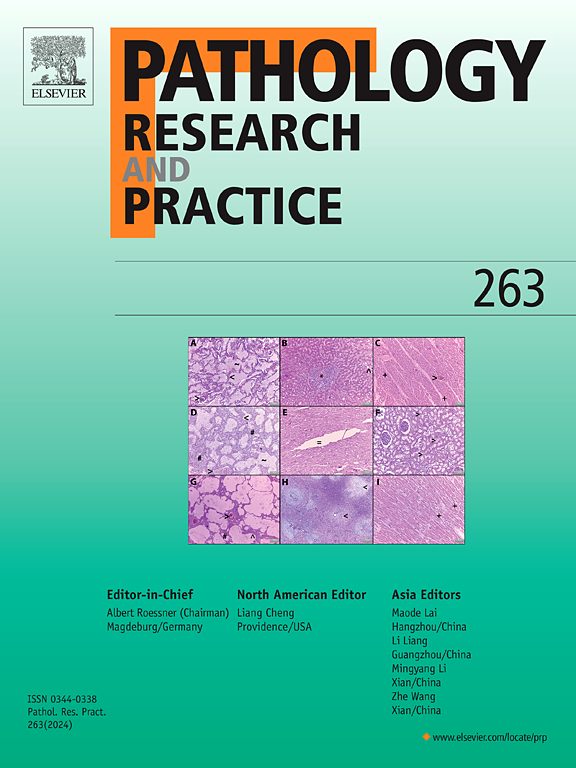SPINK1 immunohistochemistry: An ancillary tool to diagnose urothelial carcinoma in situ and urothelial dysplasia
IF 3.2
4区 医学
Q2 PATHOLOGY
引用次数: 0
Abstract
Expression of SPINK1 (Serine protease inhibitor Kazal type I), also known as tumor associated trypsin inhibitor (TATI), has been demonstrated in a wide spectrum of benign, inflammatory, and neoplastic conditions. Based on our prior results of its expression in urothelial carcinoma, in this study we further characterized SPINK1 expression in a spectrum of urothelial lesions and investigated its potential diagnostic utility. A total of 396 samples comprising a spectrum of urothelial lesions including benign, premalignant, and malignant lesions were evaluated for SPINK1 expression by immunohistochemistry and amplification by fluorescence in situ hybridization (FISH). In a subset of lesions, immunohistochemistry for CK20, CD44, and p53 was also performed. SPINK1 expression was restricted to umbrella cells or lost in 93 % of normal urothelium. Overexpression of SPINK1 in reactive urothelial atypia, urothelial dysplasia, carcinoma in situ (CIS), and papillary urothelial carcinoma (invasive and non-invasive) was seen in 21 %, 36 %, 87 % and 54 % of cases, respectively. Increasing frequency of SPINK1 loss was observed with higher pathologic stage (48.5 % in pT1, 50 % in pT2, 62.5 % in pT3). When compared with other markers, SPINK1 positivity itself has a sensitivity of 90 % for detecting CIS, a 97 % sensitivity when combined with CK20, and a 98 % sensitivity when combined with p53. No amplification of SPINK1 was detected by FISH in any case. Our study illustrates the differential expression of SPINK1 in various urothelial lesions and shows that SPINK1 immunohistochemistry can be utilized as an ancillary tool with high sensitivity and specificity for diagnosing urothelial dysplasia and CIS in challenging cases.
SPINK1免疫组织化学:诊断尿路上皮原位癌和尿路上皮发育不良的辅助工具
SPINK1(丝氨酸蛋白酶抑制剂Kazal型I),也被称为肿瘤相关胰蛋白酶抑制剂(TATI)的表达,已被证明在广泛的良性、炎症和肿瘤条件下表达。基于我们之前在尿路上皮癌中表达的结果,在本研究中,我们进一步表征了SPINK1在尿路上皮病变谱中的表达,并研究了其潜在的诊断价值。通过免疫组织化学和荧光原位杂交(FISH)扩增技术,对396例尿路上皮病变(包括良性、癌前病变和恶性病变)样本进行SPINK1表达评估。在一部分病变中,还进行了CK20、CD44和p53的免疫组织化学检测。SPINK1的表达仅限于伞细胞或在93% %的正常尿路上皮中缺失。反应性尿路上皮异型性、尿路上皮发育不良、原位癌(CIS)和乳头状尿路上皮癌(侵袭性和非侵袭性)中SPINK1过表达的病例分别为21% %、36% %、87% %和54% %。随着病理分期的增加,SPINK1丢失的频率增加(pT1为48.5% %,pT2为50% %,pT3为62.5% %)。与其他标志物相比,SPINK1阳性本身检测CIS的灵敏度为90 %,与CK20联合检测时灵敏度为97 %,与p53联合检测时灵敏度为98 %。FISH未检测到SPINK1基因扩增。我们的研究说明了SPINK1在各种尿路上皮病变中的差异表达,并表明SPINK1免疫组织化学可以作为一种具有高灵敏度和特异性的辅助工具,用于诊断挑战性病例的尿路上皮发育不良和CIS。
本文章由计算机程序翻译,如有差异,请以英文原文为准。
求助全文
约1分钟内获得全文
求助全文
来源期刊
CiteScore
5.00
自引率
3.60%
发文量
405
审稿时长
24 days
期刊介绍:
Pathology, Research and Practice provides accessible coverage of the most recent developments across the entire field of pathology: Reviews focus on recent progress in pathology, while Comments look at interesting current problems and at hypotheses for future developments in pathology. Original Papers present novel findings on all aspects of general, anatomic and molecular pathology. Rapid Communications inform readers on preliminary findings that may be relevant for further studies and need to be communicated quickly. Teaching Cases look at new aspects or special diagnostic problems of diseases and at case reports relevant for the pathologist''s practice.

 求助内容:
求助内容: 应助结果提醒方式:
应助结果提醒方式:


